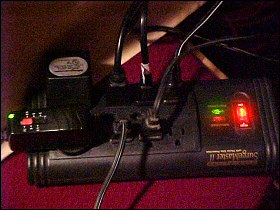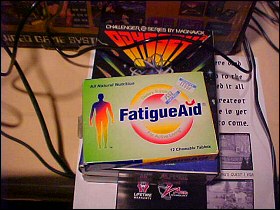After the jam-packed 2003 show, Classic Gaming Expo tried to broaden both its audience and its variety of guests of honor by moving to California – literally right into the heart of Silicon Valley, where so many stories of the industry pioneers started. Sadly, I had to miss the 2004 Expo (which featured none other than Apple Computer co-founder Steve Wozniak) due to financial concerns; I had just bought a house that year and taking a trip to California in the same 12-month period just wasn’t on. In 2005, though, I was able to swing the trip, and as always it was worth it.
 Part museum, part lecture, part arcade and part flea market, Classic Gaming Expo is the king of retrogaming events. Just walking onto the show floor to be greeted by the sight of dozens of vintage (and working) arcade games, and vendors’ tables filled with hundreds of cartridges for various old-school systems, is enough to make any vintage gamer feel like a kid in a candy store.
Part museum, part lecture, part arcade and part flea market, Classic Gaming Expo is the king of retrogaming events. Just walking onto the show floor to be greeted by the sight of dozens of vintage (and working) arcade games, and vendors’ tables filled with hundreds of cartridges for various old-school systems, is enough to make any vintage gamer feel like a kid in a candy store.
For those of us interested in the history behind these games, CGE is a double treat, because this is where you’ll find the people who lived that history. This year’s guest speakers included founding Atari engineers Al Alcorn, Steve Bristow and Steve Mayer, Fairchild Channel F inventor Jerry Lawton, the Blue Sky Rangers (the collective of programmers who created the vast majority of the Intellivision games and now own the rights to continue marketing those games on such platforms as handhelds and cell phones), and the programmers who founded the first third-party game software companies, Activision and Imagic.
Another handy place to find history is in the CGE Museum. Packed wall-to-wall with rarities, unreleased prototypes, impossible-to-find promotional items and merchandise and tons of other things that truly earn the description “one of a kind,” the Museum is a trip down memory lane and into a world of things you’ve never seen before. This year, the Museum included Al Alcorn’s hand-wired Pong prototype, the same one that legendarily got its milk jug coin collection box jammed after only a few hours in a San Francisco bar called Andy Capp’s. While most of the Museum items are out in the open where you can inspect them up close (indeed, a guard at the door asked me to leave my bag with him or I couldn’t go in), the Pong prototype machine – a custom-made, bar-top cabinet containing hand-made controls, unique one-off circuitry, and a cheap B&W TV set – was, quite rightly, under glass. And why not? It’s the prototype of the very first successful arcade game, and the first arcade game made by Atari. It’s earned a place under glass.
And for those who come with a pocket full of quarters, or other currency, you could save those for the many vendors’ booths. I spent much of my time (and money) at Pack Rat Video Games, where Jarett not only cut me a great deal on a hard-to-find Atari Video Cube cartridge, but also demonstrated a new Odyssey² homebrew called Mr. Roboto. This new game, by Planet Lander author Ted Szczypiorski, is essentially a new spin on the vintage computer game Archon, for one or two players, and it’s a heck of a lot of fun. I also spent plenty of time and dough at the 4Jays.com booth, where there were decent prices on shelves and shelves of boxed games for many systems. Their area was set up like aisles of a store, which certainly brought back more than a few memories of window shopping.
Messiah Entertainment was on hand to show off their new Generation NEX console, a hybrid machine that plays both NES cartridges and their Japanese Famicom counterparts (which, despite being essentially the same hardware, had completely different cartridge slot configurations). Despite taking pre-orders on the Generation NEX with the promise that one could pick up one’s order at CGE, they had only eight prototype consoles on hand; apparently the shipment of production models hadn’t made it past customs in time for the show. It’s an impressive, attractive and surprisingly tiny machine, compatible with either your favorite wired NES controllers or Messiah’s dandy wireless controllers. Even with the added delay, this is one piece of retrogaming gear that looks to be worth the wait.
To be fair, though, every show has its drawbacks, and CGE is no exception. I only had a few gripes with the show, but they seem fairly substantial. My biggest one had to do with the keynotes and panel discussions. These are really the heart of CGE, the one area where none of the other gaming conventions can compare. Past CGE keynote speakers have included Ralph Baer, Nolan Bushnell, Steve Wozak, Al Alcorn, Tim Skelly and many others – in a nutshell, a healthy majority of the major players in the American video and computer gaming industry. You don’t get an audience with these people every day, and you sure as hell don’t get to personally ask them questions or thank them for their contributions every day. So I find it more than a little annoying that people can’t silence their cell phones, pagers, or the free Dragon Boy games handed out to guests and attendees who stayed at the Hyatt. I know this was just a silly little convention for fans of old video games, not a world peace conference, but all the same…it’s outrageously rude. I found the sound of the little handheld Dragon Boy games to be the most enervating thing to hear during a keynote – if you’re going to sit in on a panel and play a game, quietly or otherwise, instead of listening to the folks whose work made that game possible…you’re wasting everyone’s time. I wouldn’t think that an announcement or a posted sign insisting on people shutting off games, pagers and phones would’ve been necessary, and I don’t blame the CGE organizers for not having one posted, because you’d think it wouldn’t be needed…but it looks like one is needed for the future.
Another persistent problem during the keynotes had to do with the house audio system; either there was no amplification for those speaking, or there was too much, or the thing was cranked up to the point of creating annoying feedback. (I think Activision alumnus Alan Miller did something that everybody in the room secretly wanted to do when he reached over, during the Activision Vs. Imagic panel, and quietly unplugged the offending microphone that was creating most of the feedback.) I’m not sure what the answer to this problem is, short of appointing someone to be a full-time audio engineer for the keynotes, but it had the unfortunate side-effect of occasionally making things seem a little less than professional.
That said, there were also at least two of the alumni who didn’t make their scheduled appearance either, one of whom was going to be a solo speaker. While the guest speakers and other visiting industry pioneers aren’t paid for their attendance, it was a little disappointing to see this happen this year. I’m taking it for granted that these absences were an extenuating-circumstances sort of thing that couldn’t be avoided.
The announcement was made, mere days before this year’s Classic Gaming Expo, that the retrogaming hobby’s biggest gathering will be taking a one-year vacation before returning for a promised “tenth anniversary extravaganza” in 2007. Despite all the fun that I’ve had both years that I’ve attended CGE, maybe this is a good time to hit the pause button. And it probably isn’t a bad thing.
In the years since CGE became “big,” a lot of other shows have popped up. There are now retrogaming conventions in several states on an annual or nearly-annual basis all competing for – when it comes down to it – many of the same sponsors and attendees and guests of honor. When a lot of those sponsors are small, run-out-of-somebody’s-home businesses, not many of them can afford to hit a show in California, and then in Austin or Dallas, and then in Tulsa City, and then in Milwaukee, and then in Cincinnati, and then in Philadelphia. When more than one convention lands on the same date, in two cities across the country from each other, the hobby has reached not so much a saturation point as an overkill point. Turn every hot water tap in the house, and before long, you’ve got no hot water left in the tank. The past two years have been replete with tales of sponsors and vendors not reaching the break-even point on their expenses for their various trips, let alone turning any kind of profit, to say nothing of the people who are pouring their time and effort and not-inconsiderable amounts of money into organizing the shows.
In the past 12 months, I myself have run booths at two OKGE/OVGE shows, and attended CGE, and attended a smaller get-together or two with friends of mine in the hobby. Maybe, for a little while, the latter is what those of us in the hobby need to be reminded of – returning to the living room of yesteryear where a few friends would come over and crash on your couch, mess up your house, drink all your soft drinks and play all your games. There’s been a lot of emphasis placed on programming, releasing, selling and buying homebrew games in recent years, to the degree that even the hobbyist programmers turning out these marvels of microcode are being held to (or at least relentlessly reminded of) release dates, as if they’re some kind of major publisher. In short, there’s been a bit too much emphasis on turning the retrogaming hobby into Big Business.
And for all of that Big Business thinking, there’s been very little emphasis on keeping things viable by keeping up with the ever-changing definition of “retro.” Don’t get me wrong, I buy several homebrew games a year for the Atari 2600 and the Odyssey², and I’m grateful for the brilliant programmers who continue to make new games for these systems and the vendors who continue to make them available in cartridge form. But the hobby is seeing a fresh influx of people who consider N64 and the original Playstation to be retro, and the hobby isn’t keeping up. Perhaps the reason that some of the vendors and the shows aren’t making money is because the “retro” demographic is changing and they aren’t.
As much as it may disappoint regular attendees for CGE to take a year off, it may be one of the best things for the hobby. And when it comes back, it’ll be just as much fun again, if not more.
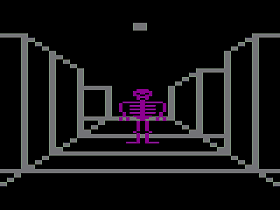
 The Game: You’re wandering through a dark, twisty maze. So are the dead, apparently, and these reanimated skeletons have a bone to pick with you. You have a single weapon with which to protect yourself, as well as a sensor that picks up on the proximity of nearby skeletons. Using the hints provided by that sensor, you must track down the living dead and dispatch them yet again – and hope they don’t get you first. (Eric Ball, 2003)
The Game: You’re wandering through a dark, twisty maze. So are the dead, apparently, and these reanimated skeletons have a bone to pick with you. You have a single weapon with which to protect yourself, as well as a sensor that picks up on the proximity of nearby skeletons. Using the hints provided by that sensor, you must track down the living dead and dispatch them yet again – and hope they don’t get you first. (Eric Ball, 2003)

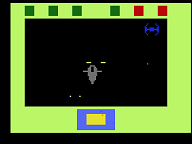 Memories: A nifty after-the-fact version of
Memories: A nifty after-the-fact version of  The Game: By passing up a lucrative programming job within ENCOM, Alan “Jet” Bradley Jr. has earned the disdain of his father, the creator of the Tron security program. But when Jet’s father disappears under mysterious circumstances, Jet goes to the lab and discovers that his father’s most trusted program, Ma3a, has instructions to digitize Jet into ENCOM’s mainframe – a process not unlike the one Kevin Flynn endured 20 years before. Once inside the computer world, Jet trains for a mission to free the system from the spreading corruption of Thorne, another digitized user whose botched entry into the computer world left him twisted and evil – and along the way, Jet hopes to discover how he can help free his father as well. (Buena Vista Interactive, 2003)
The Game: By passing up a lucrative programming job within ENCOM, Alan “Jet” Bradley Jr. has earned the disdain of his father, the creator of the Tron security program. But when Jet’s father disappears under mysterious circumstances, Jet goes to the lab and discovers that his father’s most trusted program, Ma3a, has instructions to digitize Jet into ENCOM’s mainframe – a process not unlike the one Kevin Flynn endured 20 years before. Once inside the computer world, Jet trains for a mission to free the system from the spreading corruption of Thorne, another digitized user whose botched entry into the computer world left him twisted and evil – and along the way, Jet hopes to discover how he can help free his father as well. (Buena Vista Interactive, 2003)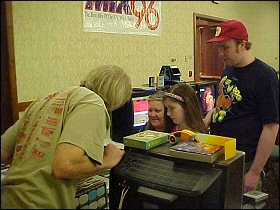 When OKGE organizer Jess Hardesty first announced a Tulsa gaming expo in the summer of 2003, I may well have been the first person to jump aboard – I was so there. And despite not having been to a gaming event at that time (OKGE was announced before I went to Classic Gaming Expo 2003), I signed on for two tables. What the heck was I thinking? From n00b to exhibitor in no time flat.
When OKGE organizer Jess Hardesty first announced a Tulsa gaming expo in the summer of 2003, I may well have been the first person to jump aboard – I was so there. And despite not having been to a gaming event at that time (OKGE was announced before I went to Classic Gaming Expo 2003), I signed on for two tables. What the heck was I thinking? From n00b to exhibitor in no time flat. shouldn’t have been driving in the first place. At the last minute, my friend Kent joined the Phosphor Dot Fossils caravan, which provided me with some extra peace of mind – I could actually vacate my table briefly. With setup scheduled for 7am, and the doors scheduled to open between 8 and 9, we had to hit the road as close to 5am as possible to make the two-hour drive.
shouldn’t have been driving in the first place. At the last minute, my friend Kent joined the Phosphor Dot Fossils caravan, which provided me with some extra peace of mind – I could actually vacate my table briefly. With setup scheduled for 7am, and the doors scheduled to open between 8 and 9, we had to hit the road as close to 5am as possible to make the two-hour drive.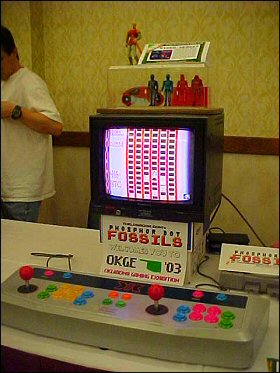 we were all finished, we had two Playstations set up with old-school controls and import-retro-compilation goodness, two Odyssey²s, and, running through a jerry-rigged Frankenstein monster of a video setup, the original 1972 Magnavox Odyssey, pumping its signal through an old VCR driving an old green monochrome monitor. Keeping the dear old thing up and running throughout the day proved to be our second biggest challenge, but Kent quickly figured out what the problem was and began keeping a regular eye on it.
we were all finished, we had two Playstations set up with old-school controls and import-retro-compilation goodness, two Odyssey²s, and, running through a jerry-rigged Frankenstein monster of a video setup, the original 1972 Magnavox Odyssey, pumping its signal through an old VCR driving an old green monochrome monitor. Keeping the dear old thing up and running throughout the day proved to be our second biggest challenge, but Kent quickly figured out what the problem was and began keeping a regular eye on it.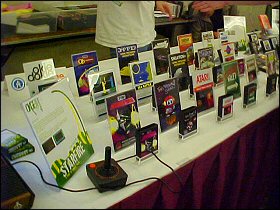 Thanks, I’ll take one of each, please.
Thanks, I’ll take one of each, please.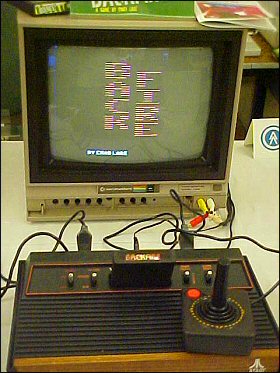
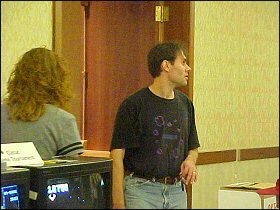 For a first-time convention, OKGE was expertly run by Jesse Hardesty, who – with his wife and mother there to help – sweated over the details to make sure everyone else was having a blast. They ran a high score contest, organized random drawing for door prizes (I donated a working Odyssey 300 Pong clone and a Sears Super Video Arcade Intellivision clone, as well as a Tron soundtrack CD and other goodies). Everyone seemed excited about their prizes!
For a first-time convention, OKGE was expertly run by Jesse Hardesty, who – with his wife and mother there to help – sweated over the details to make sure everyone else was having a blast. They ran a high score contest, organized random drawing for door prizes (I donated a working Odyssey 300 Pong clone and a Sears Super Video Arcade Intellivision clone, as well as a Tron soundtrack CD and other goodies). Everyone seemed excited about their prizes!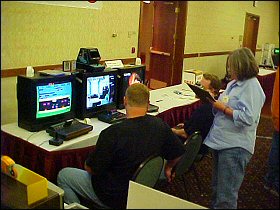 I was excited about the crowd, myself. Jesse estimates “at least 100” attendees, and I think he’s being conservative. I’d double that number at the very least. And many of them came and stayed the whole day – I saw many faces, representing many age groups and even ethnicities, circulating through the room for the entire duration.
I was excited about the crowd, myself. Jesse estimates “at least 100” attendees, and I think he’s being conservative. I’d double that number at the very least. And many of them came and stayed the whole day – I saw many faces, representing many age groups and even ethnicities, circulating through the room for the entire duration.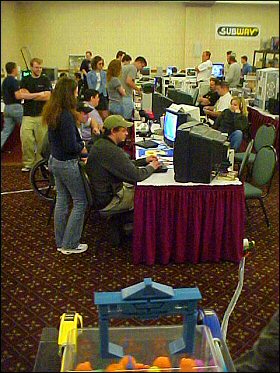
 Originally, my plan was to bring a ton of machines – i.e. 7 to 10 of them. As luck would have it, I have many more machines than I have actual screens – and this is a good thing, as five game stations spread across two-and-a-third tables were just far enough apart to avoid being elbow-to-elbow.
Originally, my plan was to bring a ton of machines – i.e. 7 to 10 of them. As luck would have it, I have many more machines than I have actual screens – and this is a good thing, as five game stations spread across two-and-a-third tables were just far enough apart to avoid being elbow-to-elbow.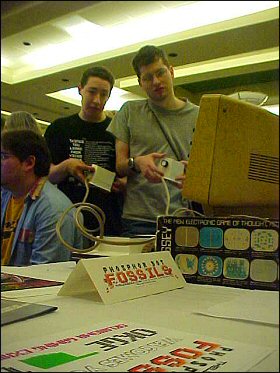 Good thing, too, because for a non-sales exhibitor, we got a lot of business – and I’d estmate that a good 80% of it was to ogle the Odyssey. People who had never seen it before, who had never seen such a thing in their lives, were just entranced by it – and with good reason. Even if you’re well-acquainted with Pong-style games, you’ve never seen anything like the Magnavox Odyssey in action. I met people who remembered seeing them back in the day, and many more people who’d never heard of one. The weird manual English control had everyone mesmerized.
Good thing, too, because for a non-sales exhibitor, we got a lot of business – and I’d estmate that a good 80% of it was to ogle the Odyssey. People who had never seen it before, who had never seen such a thing in their lives, were just entranced by it – and with good reason. Even if you’re well-acquainted with Pong-style games, you’ve never seen anything like the Magnavox Odyssey in action. I met people who remembered seeing them back in the day, and many more people who’d never heard of one. The weird manual English control had everyone mesmerized.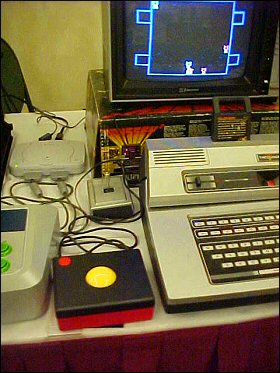 One thing about Wico’s Odyssey trakball is that it requires an AC adapter, something Kent pointed out to me after looking at the back of the controller – and something which wasn’t in the box. I had a few assorted items like that with me, but I wasn’t about to fry someone’s holy grail by misjudging the voltage required. I’m guessing that there’s not enough juice flowing through the Odyssey joystick I/O ports to power the trakball’s sensors. As it was, the fire button did work, but the controller itself was dead without power – my characters on any given game just descended to the bottom of the screen instantly. I tried it out with Killer Bees and UFO, two games that seemed like they’d be good candidates for trakball control. When the owner of the trakball returned to retrieve his treasure, I told him he could probably make decent money off of eBay with it – but I also gave him my web site’s business card and told him I’d be more than happy to buy it off of him too! Sadly, I didn’t get his name. But holy cow, I got to get my hands on a Wico Odyssey trakball – and not in Las Vegas, amazingly enough. I’ll keep everyone updated on my attempts to acquire this item! If I had brought cash with me, I would’ve made
One thing about Wico’s Odyssey trakball is that it requires an AC adapter, something Kent pointed out to me after looking at the back of the controller – and something which wasn’t in the box. I had a few assorted items like that with me, but I wasn’t about to fry someone’s holy grail by misjudging the voltage required. I’m guessing that there’s not enough juice flowing through the Odyssey joystick I/O ports to power the trakball’s sensors. As it was, the fire button did work, but the controller itself was dead without power – my characters on any given game just descended to the bottom of the screen instantly. I tried it out with Killer Bees and UFO, two games that seemed like they’d be good candidates for trakball control. When the owner of the trakball returned to retrieve his treasure, I told him he could probably make decent money off of eBay with it – but I also gave him my web site’s business card and told him I’d be more than happy to buy it off of him too! Sadly, I didn’t get his name. But holy cow, I got to get my hands on a Wico Odyssey trakball – and not in Las Vegas, amazingly enough. I’ll keep everyone updated on my attempts to acquire this item! If I had brought cash with me, I would’ve made 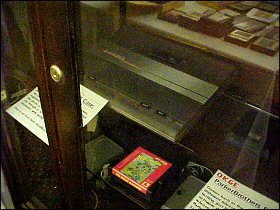 him an offer on the spot. Wow. (Editor’s note: I was later able to acquire the trackball for my collection, and it has returned to the show many times.)
him an offer on the spot. Wow. (Editor’s note: I was later able to acquire the trackball for my collection, and it has returned to the show many times.)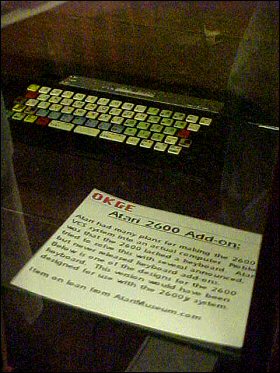
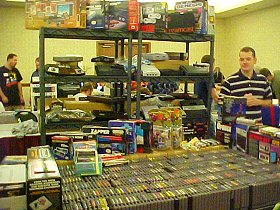 Warpzone, Vintage Stock and other vendors had very busy tables, packed with boxed games, semi-rare titles, loose carts, you name it. And just like at CGE, I wanted to buy every single one of ’em.
Warpzone, Vintage Stock and other vendors had very busy tables, packed with boxed games, semi-rare titles, loose carts, you name it. And just like at CGE, I wanted to buy every single one of ’em.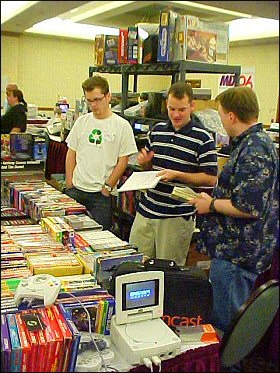


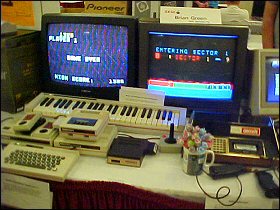
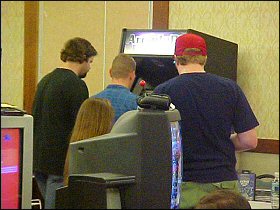
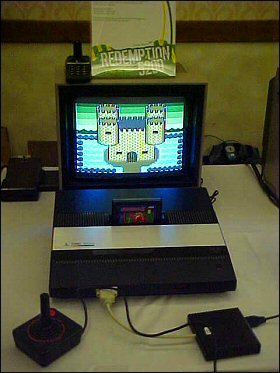
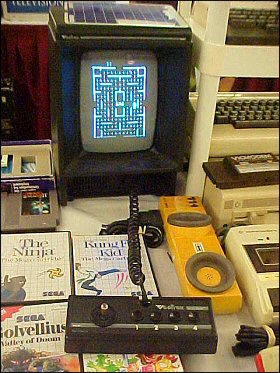
 For those not into old-school goodness, Tulsa’s own Strike Zone LAN gaming source, was on hand for a frag-fest. Other systems represented included Intellivision, the exceedingly rare Amiga CD32 on display at Brian “icbrkr” Green’s table (no relation, really), Vectrex, every flavor of Atari you can imagine (including the Jaguar and the home computers), even the Bally Astrocade.
For those not into old-school goodness, Tulsa’s own Strike Zone LAN gaming source, was on hand for a frag-fest. Other systems represented included Intellivision, the exceedingly rare Amiga CD32 on display at Brian “icbrkr” Green’s table (no relation, really), Vectrex, every flavor of Atari you can imagine (including the Jaguar and the home computers), even the Bally Astrocade.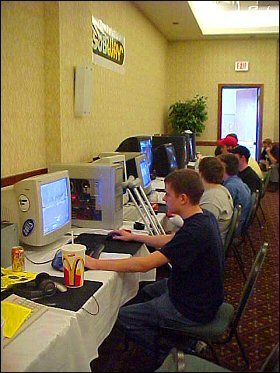
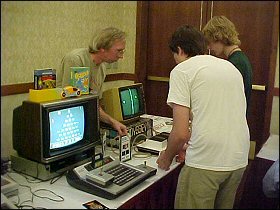

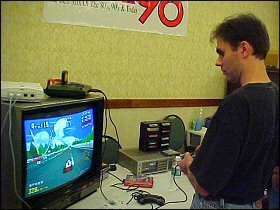 Finally, close to the planned closing time for the show, the crowd thinned out, and some vendors broke down their displays and hit the road ahead of schedule (but some of them, like Warpzone, had a very long drive home ahead of them). Jess had time to get a few games in (and so did his mom – 2600 Frogger, no less!), and we still had people playing the Odyssey (and nothing else – I had time play the PS1 and Odyssey², and set myself up a mean game of Missile Command complete with trakball). And before you know it, the show’s over, the crowd’s gone, and everybody’s packing their wares. I suppose I must have
Finally, close to the planned closing time for the show, the crowd thinned out, and some vendors broke down their displays and hit the road ahead of schedule (but some of them, like Warpzone, had a very long drive home ahead of them). Jess had time to get a few games in (and so did his mom – 2600 Frogger, no less!), and we still had people playing the Odyssey (and nothing else – I had time play the PS1 and Odyssey², and set myself up a mean game of Missile Command complete with trakball). And before you know it, the show’s over, the crowd’s gone, and everybody’s packing their wares. I suppose I must have 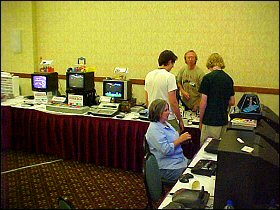 been in denial – by the time Kent and I broke down the Phosphor Dot Fossils display, AtariAge was the only other vendor left, and Jess and his family were trying to get his gear packed up.
been in denial – by the time Kent and I broke down the Phosphor Dot Fossils display, AtariAge was the only other vendor left, and Jess and his family were trying to get his gear packed up. Don’t leave the most popular system in the corner. I had the Odyssey in a corner where people were crunched up against the Hardestys’ high-score competition table. I should’ve taken a moment to move the necessary gear to the other side of my table to make things more accessible. Then again, the Odyssey had so little downtime, I’m not sure I could’ve done so without upsetting anyone. Next year, the Odyssey will be back – and it’ll be front and center.
Don’t leave the most popular system in the corner. I had the Odyssey in a corner where people were crunched up against the Hardestys’ high-score competition table. I should’ve taken a moment to move the necessary gear to the other side of my table to make things more accessible. Then again, the Odyssey had so little downtime, I’m not sure I could’ve done so without upsetting anyone. Next year, the Odyssey will be back – and it’ll be front and center.
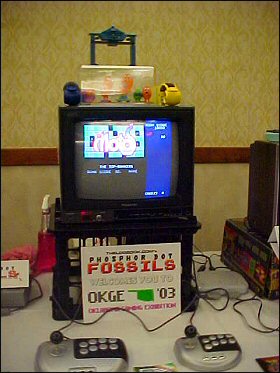 More signage! As if I could’ve possibly squeezed the Phosphor Dot Fossils logo onto one more thing. But I should’ve had instructions for every single game I brought with me to display. Some of the PS1 and Odyssey² stuff, people wouldn’t touch – because it was just sitting there and because I was a bit sleepy to try to be a carny for it. The Odyssey, on the other hand – well, basically, it’s just like Pong. Everyone knows how to play it.
More signage! As if I could’ve possibly squeezed the Phosphor Dot Fossils logo onto one more thing. But I should’ve had instructions for every single game I brought with me to display. Some of the PS1 and Odyssey² stuff, people wouldn’t touch – because it was just sitting there and because I was a bit sleepy to try to be a carny for it. The Odyssey, on the other hand – well, basically, it’s just like Pong. Everyone knows how to play it.
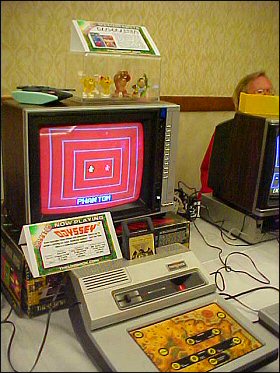 Get more sleep. Pretty self-explanatory.
Get more sleep. Pretty self-explanatory.

 Memories: I love Namco. When I go looking up my favorite classic
Memories: I love Namco. When I go looking up my favorite classic 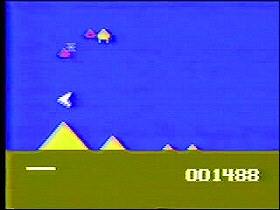 Aliens are attacking several idyllic locales on Earth, and it’s your job to fend off the attack. Not only are you charged with blasting the aliens themselves out of the sky, but you must intercept as much of their incoming fire as possible before it hits targets on the ground. If you save the various trees and cars and castles and trains and boats and whatnot, not only have you earned the gratitude of the human race, you get big bonus points too, and we all know which is more important. Your highly maneuverable ship is equipped with shields which allow you to absorb the impact of collisions with the alien ships, as well as protecting you from direct hits from their weapons. But each hit and collision takes a significant chunk out of your shields. You can replenish them with power-ups left behind by fallen aliens, but when your shields run out and your ship takes another hit, your alien-killing days are over. (Soren Gust [published by Packrat Video Games], 2004)
Aliens are attacking several idyllic locales on Earth, and it’s your job to fend off the attack. Not only are you charged with blasting the aliens themselves out of the sky, but you must intercept as much of their incoming fire as possible before it hits targets on the ground. If you save the various trees and cars and castles and trains and boats and whatnot, not only have you earned the gratitude of the human race, you get big bonus points too, and we all know which is more important. Your highly maneuverable ship is equipped with shields which allow you to absorb the impact of collisions with the alien ships, as well as protecting you from direct hits from their weapons. But each hit and collision takes a significant chunk out of your shields. You can replenish them with power-ups left behind by fallen aliens, but when your shields run out and your ship takes another hit, your alien-killing days are over. (Soren Gust [published by Packrat Video Games], 2004)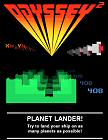
 Travel back in time to the dawn of interactive electronic games. Pong For Odyssey² offers a standard two-player version of the classic video table tennis game, as well as electronic recreations of the analog version of the game available on the first home game
Travel back in time to the dawn of interactive electronic games. Pong For Odyssey² offers a standard two-player version of the classic video table tennis game, as well as electronic recreations of the analog version of the game available on the first home game 
 The Game: Somewhere in London, an alien menace is in the early stages of hatching a plan for world domination, and since he’s dropped Rose off to take part in an important historical event (namely, the 1979 Abba concert at Wembley Stadium), the Doctor asks you to help him find it. After the Doctor ties into your remote control with his sonic screwdriver, your first task is to monitor a seemingly normal family at Christmastime for any hints of alien incursion. The Doctor suspects the alien is a Graske, who invades worlds by replacing people, one at a time, with duplicates that he controls. Once spotted, the Graske leads the TARDIS on a wild goose chase through the time vortex, and the Doctor relies on you to help him operate his timeship’s controls in rapid succession. The chase leads back to Earth, but in an earlier era, where the Graske decides to try launching his invasion at a more vulnerable point in Earth’s history. It’s up to you to spot the Graske and then to accompany the Doctor to the Graske’s home planet, where you have to crack the codes to break into the creature’s inner sanctum and then put an end to his invasion plans. (BBC Interactive, 2005)
The Game: Somewhere in London, an alien menace is in the early stages of hatching a plan for world domination, and since he’s dropped Rose off to take part in an important historical event (namely, the 1979 Abba concert at Wembley Stadium), the Doctor asks you to help him find it. After the Doctor ties into your remote control with his sonic screwdriver, your first task is to monitor a seemingly normal family at Christmastime for any hints of alien incursion. The Doctor suspects the alien is a Graske, who invades worlds by replacing people, one at a time, with duplicates that he controls. Once spotted, the Graske leads the TARDIS on a wild goose chase through the time vortex, and the Doctor relies on you to help him operate his timeship’s controls in rapid succession. The chase leads back to Earth, but in an earlier era, where the Graske decides to try launching his invasion at a more vulnerable point in Earth’s history. It’s up to you to spot the Graske and then to accompany the Doctor to the Graske’s home planet, where you have to crack the codes to break into the creature’s inner sanctum and then put an end to his invasion plans. (BBC Interactive, 2005)





 The Game: The Odyssey²’s keyboard and processing power are at your disposal for any number of mathematical tasks. If you can do it on an adding machine or a low-end handheld scientific calculator, you can do it on Calculator!
The Game: The Odyssey²’s keyboard and processing power are at your disposal for any number of mathematical tasks. If you can do it on an adding machine or a low-end handheld scientific calculator, you can do it on Calculator! 
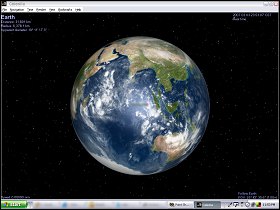 The Game: Not a game, but a powerful (and free) space simulator, Celestia lets you pick what celestial bodies you observe, from any distance or close-up. You can tell Celestia to put convenient labels on any or all of the heavenly objects, or none of them, and even pick a minimum magnitude for background stars. But they’re not just wallpaper – you can click on and travel to any one of them, and you can follow them in a variety of ways. Add-on packages offer everything from updated imagery and orbital information for real planets, moons, comets and vehicles, as well as fictional add-ons for those who are feeling a bit fanciful. (Celestia Development Group, 2006)
The Game: Not a game, but a powerful (and free) space simulator, Celestia lets you pick what celestial bodies you observe, from any distance or close-up. You can tell Celestia to put convenient labels on any or all of the heavenly objects, or none of them, and even pick a minimum magnitude for background stars. But they’re not just wallpaper – you can click on and travel to any one of them, and you can follow them in a variety of ways. Add-on packages offer everything from updated imagery and orbital information for real planets, moons, comets and vehicles, as well as fictional add-ons for those who are feeling a bit fanciful. (Celestia Development Group, 2006)
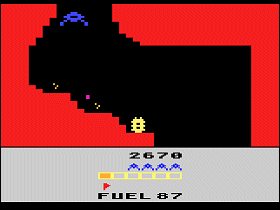
 The Game: DSI strikes again with Gauntlet and Rampage, two nearly perfect arcade conversions for the Game Boy Advance. In Gauntlet you’ll trade shots with ghosts, demons, and Death himself. In Rampart you’ll defend your ground and exchange buckshot with more worldly enemies. (DSI Games/Atari, 2006)
The Game: DSI strikes again with Gauntlet and Rampage, two nearly perfect arcade conversions for the Game Boy Advance. In Gauntlet you’ll trade shots with ghosts, demons, and Death himself. In Rampart you’ll defend your ground and exchange buckshot with more worldly enemies. (DSI Games/Atari, 2006) The Game: Relive exciting arcade action on your Gameboy Advance with the latest game pack from DSI Games. Millipede, Super Breakout and Lunar Lander, three classic games from Atari, are waiting for you! (DSI Games/Atari, 2006)
The Game: Relive exciting arcade action on your Gameboy Advance with the latest game pack from DSI Games. Millipede, Super Breakout and Lunar Lander, three classic games from Atari, are waiting for you! (DSI Games/Atari, 2006)
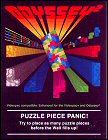 The Game: Interconnecting puzzle pieces are spewed out of the sky by the Tetrad Ejection Device (T.E.D.) and drift down the screen in a pre-defined area. You can rotate them for better placement (or at least rotate them to achieve the least worst effect); filling an
The Game: Interconnecting puzzle pieces are spewed out of the sky by the Tetrad Ejection Device (T.E.D.) and drift down the screen in a pre-defined area. You can rotate them for better placement (or at least rotate them to achieve the least worst effect); filling an  The Game: Wii Play gathers a collection of mini-games in one place, from fishing, billiards and target shooting to a futuristic hockey game and tank battles, each showcasing different ways that the Wii remote controls
The Game: Wii Play gathers a collection of mini-games in one place, from fishing, billiards and target shooting to a futuristic hockey game and tank battles, each showcasing different ways that the Wii remote controls 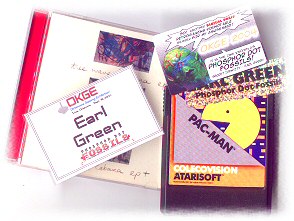 The second – and I really hope I’m not stepping too far out of line into the realm of wishful thinking in saying second annual – Oklahoma Gaming Exhibition was my only shot at making it to any of the retrogaming events in 2004. As much as I had wanted to go to CGE as well, I also became a homeowner in 2004 and learned the art of prioritizing, and a trip to San Jose just wasn’t possible this year. OKGE is only a two hour drive to Tulsa, however, so there was no way I was going to miss it. I don’t want to get any debate going by comparing OKGE to CGE, but I will say this: if the only gaming event one could attend in 2004 was OKGE, it’d be hard to ask for a better show.
The second – and I really hope I’m not stepping too far out of line into the realm of wishful thinking in saying second annual – Oklahoma Gaming Exhibition was my only shot at making it to any of the retrogaming events in 2004. As much as I had wanted to go to CGE as well, I also became a homeowner in 2004 and learned the art of prioritizing, and a trip to San Jose just wasn’t possible this year. OKGE is only a two hour drive to Tulsa, however, so there was no way I was going to miss it. I don’t want to get any debate going by comparing OKGE to CGE, but I will say this: if the only gaming event one could attend in 2004 was OKGE, it’d be hard to ask for a better show. The centerpiece of my display this year was meant to be an elaborate video loop chronicling the entire early history of video games, with key arcade games and home consoles front and center…but to my shock, the DVD player I brought along with me to play this loop was defective (it was a spare that we hadn’t taken out of the box and tried out before, and I didn’t bring a backup, so my apologies to those who wondered why the display went no further than 1980). This project will been seen in its entirety at next year’s OKGE – and I think you’ll like it even more. Loads of vintage commercials, clips from game-inspired cartoons, and well over a hundred shots of games in action that you may not have seen in years. So again, to anyone wondering where the display went – my apologies. It’ll be back next year.
The centerpiece of my display this year was meant to be an elaborate video loop chronicling the entire early history of video games, with key arcade games and home consoles front and center…but to my shock, the DVD player I brought along with me to play this loop was defective (it was a spare that we hadn’t taken out of the box and tried out before, and I didn’t bring a backup, so my apologies to those who wondered why the display went no further than 1980). This project will been seen in its entirety at next year’s OKGE – and I think you’ll like it even more. Loads of vintage commercials, clips from game-inspired cartoons, and well over a hundred shots of games in action that you may not have seen in years. So again, to anyone wondering where the display went – my apologies. It’ll be back next year.
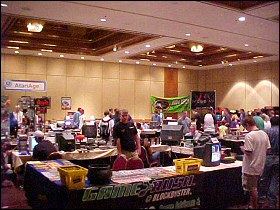
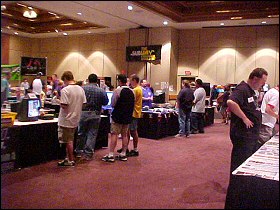

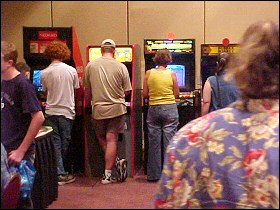
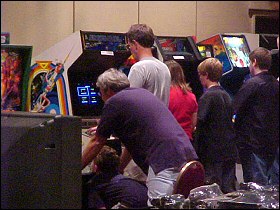

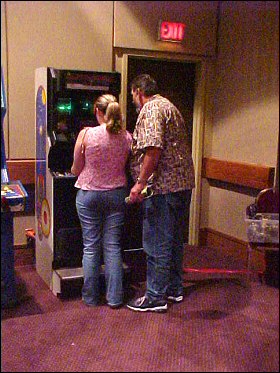
 The OKGE arcade had a nice sampling of classic and more recent coin-ops, from Battlezone and Gorf to a Neo-Geo cabinet and Namco Classic Collection. There was also a Teenage Mutant Ninja Turtles pinball machine on hand, and many of the coin-ops were for sale.
The OKGE arcade had a nice sampling of classic and more recent coin-ops, from Battlezone and Gorf to a Neo-Geo cabinet and Namco Classic Collection. There was also a Teenage Mutant Ninja Turtles pinball machine on hand, and many of the coin-ops were for sale.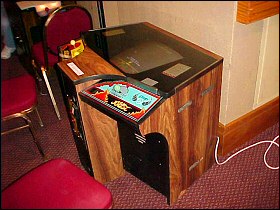
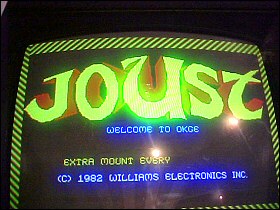

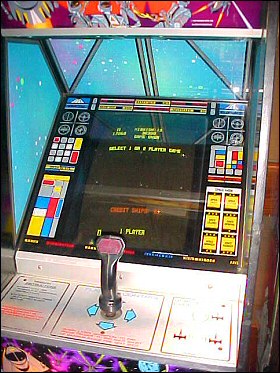
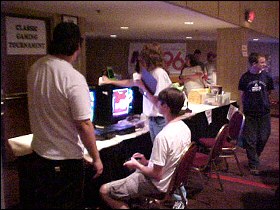
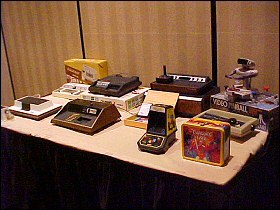
 The busy OKGE tournament table offered high-score contests as well as plain old door prize drawings, held every hour.
The busy OKGE tournament table offered high-score contests as well as plain old door prize drawings, held every hour.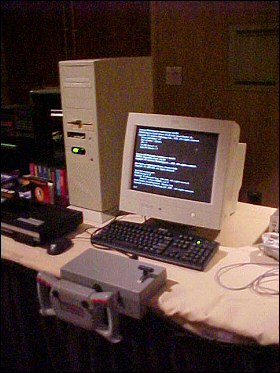 And maybe after that, he can play some games on the Ivory Tower – a high-powered thing of beauty that he’s put together solely for the purpose of getting the biggest oomph out of DOS games.
And maybe after that, he can play some games on the Ivory Tower – a high-powered thing of beauty that he’s put together solely for the purpose of getting the biggest oomph out of DOS games.
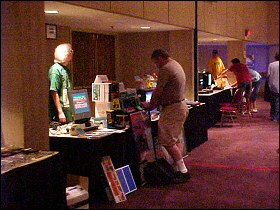
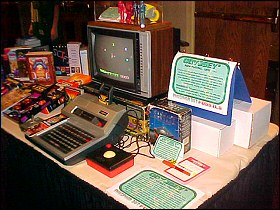

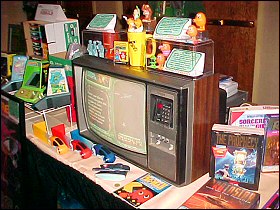
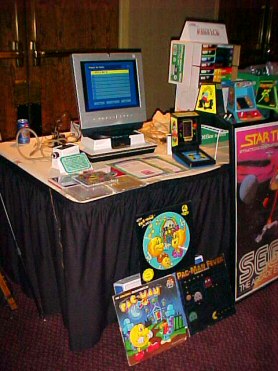

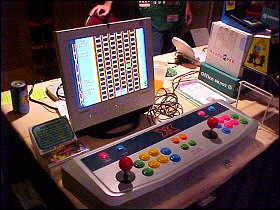
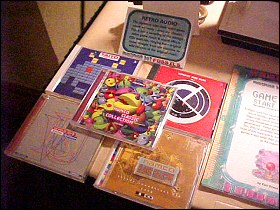
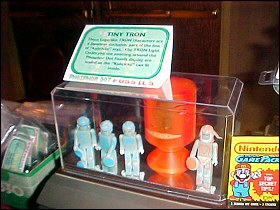
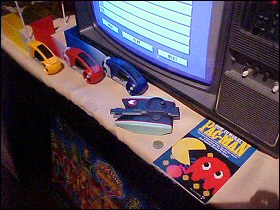
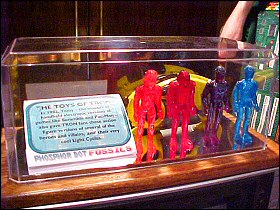
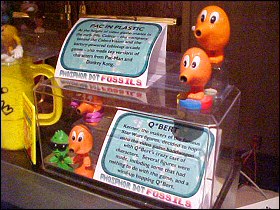

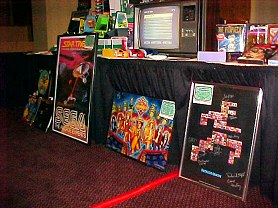
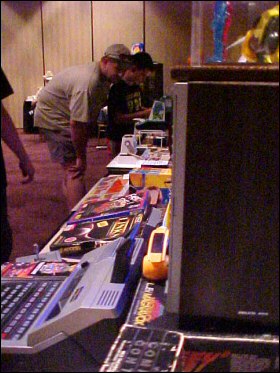
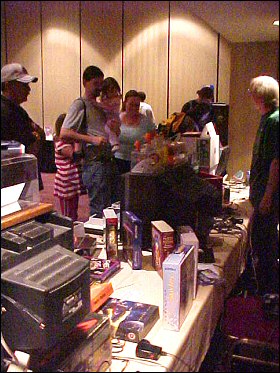
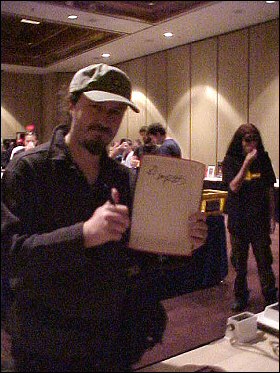

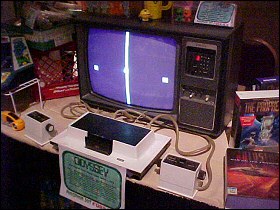

 Ah, there’s the little fellow now. I used to have one of these Pac-Man wind-up toys some 20 years ago, and right before the doors opened to the public, Lynda from Lynda’s Action Figures in Stillwater, OK came up to me and offer me the first shot at this little guy, and at a discounted price too. Just another example of the great friendly atmosphere at OKGE 2004.
Ah, there’s the little fellow now. I used to have one of these Pac-Man wind-up toys some 20 years ago, and right before the doors opened to the public, Lynda from Lynda’s Action Figures in Stillwater, OK came up to me and offer me the first shot at this little guy, and at a discounted price too. Just another example of the great friendly atmosphere at OKGE 2004.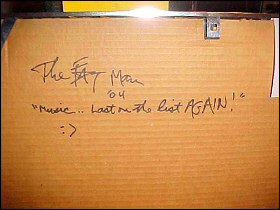 The back of the Intellivision poster, signed by George “The Fat Man” Sanger himself. We couldn’t find a silver ink pen for him, but he came up with the gag of signing the backboard because “the music is the last thing on the list…again!” (One of George’s earliest video game compositions was the theme for the Intellivision game Thin Ice, back when having music in a cartridge game was a luxury.) I would’ve gotten a picture of him signing it, but I was having such a great time chatting with him that I completely forgot to grab the camera.
The back of the Intellivision poster, signed by George “The Fat Man” Sanger himself. We couldn’t find a silver ink pen for him, but he came up with the gag of signing the backboard because “the music is the last thing on the list…again!” (One of George’s earliest video game compositions was the theme for the Intellivision game Thin Ice, back when having music in a cartridge game was a luxury.) I would’ve gotten a picture of him signing it, but I was having such a great time chatting with him that I completely forgot to grab the camera.